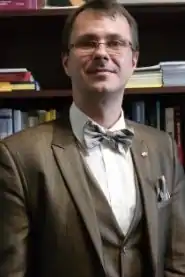Nikodem Popławski
Nikodem Janusz Popławski (born March 1, 1975) is a Polish theoretical physicist, most widely noted for the hypothesis that every black hole could be a doorway to another universe and that the universe was formed within a black hole which itself exists in a larger universe.[1][2][3][4][5][6][7] This hypothesis was listed by National Geographic and Science magazines among their top ten discoveries of 2010.[8][9] Popławski appeared in an episode of the TV show Through the Wormhole titled "Are There Parallel Universes?" and in an episode of the Discovery Channel show Curiosity titled "Is There a Parallel Universe?",[10] which were hosted by Morgan Freeman and aired in 2011. He was named by Forbes magazine in 2015 as one of five scientists in the world most likely to become the next Albert Einstein.[11]
Nikodem Popławski | |
|---|---|
 Nikodem Popławski, 2015 | |
| Born | 1 March 1975 Toruń, Poland |
| Nationality | Polish, American |
| Alma mater | |
| Known for | |
| Scientific career | |
| Fields | Theoretical physics |
| Institutions | |
Black holes as doorways
Popławski's approach is based on the Einstein–Cartan theory of gravity which extends general relativity to matter with intrinsic angular momentum (spin). Spin in curved spacetime requires that the affine connection cannot be constrained to zero and its antisymmetric part, the torsion tensor, must be a variable in Hamilton's principle of stationary action which gives the field equations. Torsion gives the correct generalization of the conservation law for the total (orbital plus intrinsic) angular momentum to the presence of the gravitational field, but also modifies the Dirac equation for fermions.
Gravitational effects of torsion on fermionic matter are significant at extremely high densities which exist inside black holes and at the beginning of the Universe. Popławski theorizes that torsion manifests itself as a repulsive force which causes fermions to be spatially extended and prevents the formation of a gravitational singularity within the black hole's event horizon.[12] Because of torsion, the collapsing matter on the other side of the horizon reaches an enormous but finite density, explodes and rebounds, forming an Einstein-Rosen bridge (wormhole) to a new, closed, expanding universe.[13][14] Analogously, the Big Bang is replaced by the Big Bounce before which the Universe was the interior of a black hole.[15] This scenario generates cosmic inflation, which explains why the present Universe at largest scales appears spatially flat, homogeneous and isotropic.[16][17] It may explain the arrow of time, solve the black hole information paradox, and explain the nature of dark matter.[18] Torsion may also be responsible for the observed asymmetry between matter and antimatter in the Universe.[19] The rotation of a black hole could influence the spacetime on the other side of its event horizon and result in a preferred direction in the new universe. Popławski suggests that the observed fluctuations in the cosmic microwave background might provide evidence for his hypothesis.[20]
Education
Popławski received his M.S. degree in astronomy from the University of Warsaw (1999), and his Ph.D. degree in physics from Indiana University (2004), where he later worked as a researcher and lecturer in physics. Since 2013, he has been a senior lecturer in the Department of Mathematics and Physics at the University of New Haven.
See also
References
- National Geographic Daily News: "Every Black Hole Contains Another Universe?"
- Science News: "Does Our Universe Live Inside a Wormhole?"
- Space.com: "Our Universe Was Born in a Black Hole, Theory Says"
- "Every black hole may hold a hidden universe" in New Scientist, Vol. 207, No. 2770, p. 9 (2010)
- National Geographic Daily News: "Are We Living in a Black Hole?"
- BBC iWonder: "How do we know the Big Bang actually happened?"
- Smithsonian: "What Is the Universe? Real Physics Has Some Mind-Bending Answers"
- National Geographic Daily News: "Top Ten Discoveries of 2010: Nat Geo News's Most Popular"
- Science News: "Top 10 ScienceNOWs of 2010"
- Nikodem Poplawski - IMDb"
- Forbes: "The Next Einstein May Be A 27-Year-Old Iranian Woman"
- N. J. Popławski (2010). "Nonsingular Dirac particles in spacetime with torsion". Physics Letters B. 690 (1): 73–77. arXiv:0910.1181. Bibcode:2010PhLB..690...73P. doi:10.1016/j.physletb.2010.04.073.
- N. J. Popławski (2010). "Radial motion into an Einstein-Rosen bridge". Physics Letters B. 687 (2–3): 110–113. arXiv:0902.1994. Bibcode:2010PhLB..687..110P. doi:10.1016/j.physletb.2010.03.029.
- N. J. Popławski (2010). "Cosmology with torsion: An alternative to cosmic inflation". Physics Letters B. 694 (3): 181–185. arXiv:1007.0587. Bibcode:2010PhLB..694..181P. doi:10.1016/j.physletb.2010.09.056.
- N. Popławski (2012). "Nonsingular, big-bounce cosmology from spinor-torsion coupling". Physical Review D. 85 (10): 107502. arXiv:1111.4595. Bibcode:2012PhRvD..85j7502P. doi:10.1103/PhysRevD.85.107502.
- N. Popławski (2016). "Universe in a black hole in Einstein-Cartan gravity". Astrophysical Journal. 832 (2): 96. arXiv:1410.3881. doi:10.3847/0004-637X/832/2/96.
- G. Unger, N. Popławski (2019). "Big Bounce and closed Universe from spin and torsion". Astrophysical Journal. 870 (2): 78. arXiv:1808.08327. doi:10.3847/1538-4357/aaf169.
- N. J. Popławski (2014). "The energy and momentum of the Universe". Classical and Quantum Gravity. 31 (6): 065005. arXiv:1305.6977. Bibcode:2014CQGra..31f5005P. doi:10.1088/0264-9381/31/6/065005.
- N. J. Popławski (2011). "Matter-antimatter asymmetry and dark matter from torsion". Physical Review D. 83 (8): 084033. arXiv:1101.4012. Bibcode:2011PhRvD..83h4033P. doi:10.1103/PhysRevD.83.084033.
- S. Desai, N. J. Popławski (2016). "Non-parametric reconstruction of an inflaton potential from Einstein–Cartan–Sciama–Kibble gravity with particle production". Physics Letters B. 755: 183–189. arXiv:1510.08834. Bibcode:2016PhLB..755..183D. doi:10.1016/j.physletb.2016.02.014.
